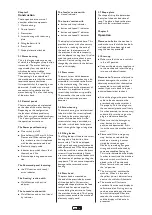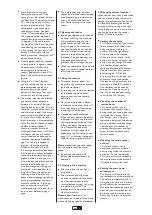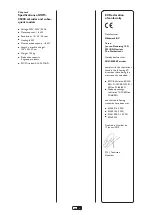
Chapter 2
Construction
The soap extruder consists of
a number of basic components.
1 Motor housing-
2 Control panels
3 Press screw
4 Screw housing with the mixing
plate
5 Filling feeder with lid
6 Press head-
7 Shape plates are attached
2.1 Motor housing
This is the large purple case on top
of which the ‘Emergency Stop’ button
is mounted. The motor housing is
supported by four adjustable feet
which can be set to stabilise
the machine using a no. 17 spanner.
The opening in the underside of
the machine ensures that the motor
receives adequate ventilation.
It’s important that this opening is not
obstructed. A cable with a round
connector is also attached to the
motor housing. This is for the heating
of the press head.
2.2 Control panels
The two control panels are located
on the sides of the motor housing:
Depending on the configuration,
the locations of these panels may
differ (left- or right handed machines).
This is not significant to the rest of
the operation instructions.
The Power panel featuring:
●
Main switch
(on /off)
●
Fuse holder with 20 mm 16 A fuse.
Please note! When replacing the
fuse, make sure that it is replaced
with the abovementioned type!
●
Electricity supply cable
●
Indicator lamp which shows that
the machine is live.
●
‘Remote’ operating pedal connec-
tion.
The Command panel featuring:
●
the ‘ZX’ section with
‘ready /
error’ indicator
The
‘heating’ section with:
●
On /off button with ‘active’
indicator
The
‘remote’ section with:
●
On /off button and ‘active / stand-
by’ indicator
The
‘feeder’ section with:
●
‘closed’ indicator
The
‘motor’ section with
●
button and
‘stop’ indicator
●
button and
‘speed 1’ indicator
●
button and
‘speed 2’ indicator
●
button and
‘speed 3’ indicator
The display is also located here. This
provides the user with all necessary
information, including the state of
the machine, the temperature of
the press head, the motor capacity
and the elapsed running time. It is also
used to provide instructions in case
of errors. Certain settings can be
changed by the user with the buttons
next to this display.
2.3 Press screw
The press screw, which becomes
visible when the screw housing is dis-
assembled, is attached to the motor
in the motor housing. The soap is
pushed forward by the movement of
the screw. It’s important that this
screw is kept as clean as is possible.
The smoother the screw, the more
efficient the extrusion process
becomes.
2.4 Screw housing
The screw housing is a stainless steel
tube into which the screw is placed.
It is fixed to the motor housing by
means of three hex bolts. As the
screw rotates, soap is extruded via
this tube – which leads to the press
head - through the large mixing plate.
2.5 Filling feeder
The filling feeder is fixed to the screw
housing and is fitted with a lid to
ensure safety. The lid is equipped
with a grid, and soap granulate can be
added from above. If the lid is opened
while the machine is active, the press
screw will stop immediately. Never
insert any objects into the feeder with
the intention of, perhaps, pushing the
soap down. This can cause irre parable
damage to the screw and screw
housing.
2.6 Press head
The press head is mounted on
the end of the press tube by means
of three hex bolts. Various inter-
changeable shape plates can be fixed
to this head. For optimum perfor-
mance during the extrusion of soap,
the press head is heated. This heating
system is connected to the machine’s
electricity supply cord.
2.7 Shape plate
The shape of this plate determines
the style of the extruded stave of
soap. The plate is fixed to the press
head with four crosshead screws.
Chapter 3
Operation
Please note:
Before the machine is
used, make sure that all the hex bolts
are fitted and have been tightened
using the hex key provided!
3.1 Start-up
●
Makes sure that the main switch is
in the
‘off’ position.
●
Connect the electricity supply cord
to the machine and insert the plug
into an earthed wall socket.
Please note:
To ensure safety and to
prevent damage to the machine, it is
absolutely essential that the machine
is connected to a suitably earthed
socket. If you are in doubt, ask your
technical department to check.
●
Attach the plug on the press heater
cable to the connector on the
press head and make sure that it
fits properly: Push the plug onto
the connector (
please note! It only
fits when inserted in a certain way)
and carefully turn the ring on the
plug in a clockwise direction.
●
Make sure that the
‘emergency
stop’ button is in its upward
position and deactivated. If this
is not the case, the machine won’t
start!
●
Please note! If the
‘emergency
stop’ button is used while the
machine is working, it cannot
simply be turned on again.
Obviously something has gone
wrong and must be checked by
someone capable of doing so.
This is also indicated on the display.
In order to reactivate the machine,
the main switch must first be
placed in the
‘off’ position and,
after a few minutes, returned to
the
‘on’ position.
●
The ‘main switch’ activates the
machine. When it is turned on,
the yellow
‘power’ indicator lamp
next to this switch will illuminate.
●
The machine will first test a
number of functions and display its
software version. During start-up,
you do not need to pay attention
to what is displayed. After two
seconds, the machine will start
and the display will indicate its
processes.
EN
2























